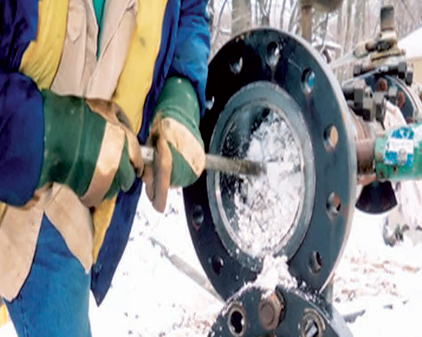Hydrate growth inhibitors (HGI)
Why control hydrate formation? Development of natural gas hydrates may threaten any low temperature and high pressure production system. Unlike paraffins, asphaltenes and scaling, hydrates may block oil and gas pipelines with or without minimum signs of forthcoming complication. The most sensitive systems are the ones with intermittent start-stop cycles, when temperature drops and pressure peaks are possible, and water may accumulate in low sections.
HI-M-PACTTM Low-Dose HG Inhibitors will ensure hydrate formation control in the toughest environments with only percents of regular methanol or glycol consumption.
Product advantages:
• Uninterruptable production;
• Safer and environmentally friendly production;
• Reduced exposure to hazardous substances, fixing of flammable and toxic material logistic issues;
• Low dosing, less feeding power and decrease in transportation costs;
• Reduced CAPEX and OPEX, no need in regeneration equipment;
• Reduced treatment costs;
• Removal of methanol pollution, higher product quality;
• Minimized adverse impact of methanol upon oil/water separation;
• Removal of methanol-related scaling;
• Removal of oxygen corrosion related to high solubility of oxygen in methanol. Antiagglomerants (АА) HI-M-PACTTM antiagglomerants are designed for specific interaction with a growing hydrate crystal surface.
These products will not prevent hydrate formation but force against aggregation and deposition of hydrates in the pipelines and their plugging. АА are effective in the presence of sufficient amount of liquid HC phase, where АА could be dispersed.
Kinetic Hydrate Inhibitors (KHI). HI-M-PACTTM kinetic hydrate inhibitors action is based on nucleation and/or growth restriction. This delay time is often called induction time. Time required for hydrate formation and subsequent growth rate will depend on KHI efficiency, its dosing and hydrate formation tendency evidence. Stronger subcooling will require more KHI amount, and this will result in shorter period for hydrate growth restriction. KHI are mostly cost-effective for low to moderate subcooling conditions. For high subcooling rates hydrate formation is controlled through combination of KHI with methanol or glycol in order to ensure the most cost-effective solution.
Support and service from Topan engineers alongside with Baker Hughes will provide accurate forecast of hydrate formation conditions in a system, and recommend various types of treatment to ensure flow and process safety. They will also provide service support to implement, monitor and optimize application of HI-M-PACTTM inhibitors.
Our projects
Useful
Reviews
Head count
-
Как Вам наш сайт ENGLISH?
Нравиться 0 (%) Не нравиться 0 (%) Воздержусь 0 (%)


